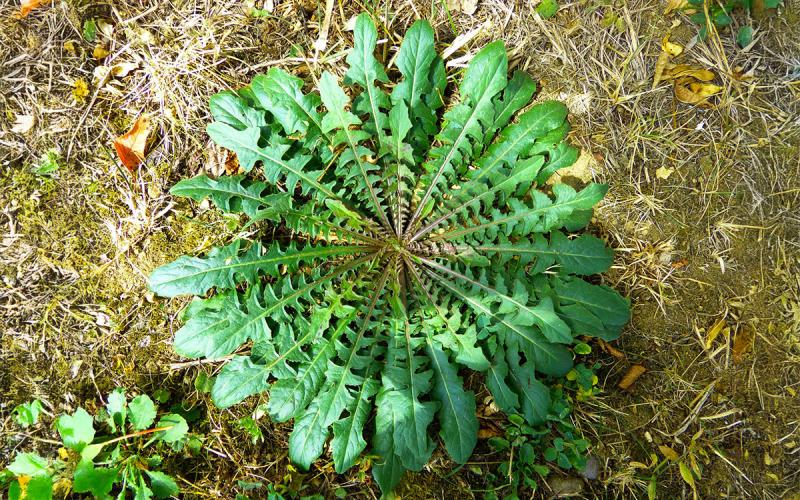Fall herbicide applications provide the best control of perennial weeds, such as dandelions, because perennials send more resources to their roots in preparation for winter. However, if dandelions are present on your property this spring, an herbicide application may still be worthwhile because it can kill the above ground growth, meaning a reduced likelihood for seed production that will worsen problem.
Pre-Bloom Herbicide Application

A two-year study by Raudenbush and Keeley (2014) evaluated different lawn-safe herbicide mixtures applied at the pre-bloom, peak-bloom, or post-bloom growth stages of dandelions in Kansas. With a pre-bloom application timing (leaves present, but no flowers), they typically reported >90% control at 30 days after application with various products containing 2,4-D. 2,4-D belongs to the synthetic auxin family of herbicides that also includes the common lawn herbicides of mecoprop (MCPP), dicamba, and quinclorac. This family of herbicides kills weeds by causing them to grow out of control (twisting of stems, cupping of leaves) until they die. These herbicides work slowly, often requiring a couple weeks to kill the weed. Since weeds need to be actively growing for synthetic auxin herbicides to be effective, daily high temperatures should be 60 to 85 degrees Fahrenheit for several days following the application. Daily lows during this time should also remain above freezing, and preferably >40 degrees Fahrenheit. Adequate soil moisture helps the performance of these herbicides.
Weed and feed products normally contain a blend of fertilizers and synthetic auxin herbicides to fertilize lawns and control weeds with the same application. Unfortunately, applying nitrogen (N) fertilizer during dandelion pre-bloom may inhibit lawn root development compared to applying several weeks later in May. A strong root system helps lawns tolerate summer drought conditions. Dry products, similar to weed and feed, but without the N fertilizer component, are available on many store shelves. These products can be spread with an inexpensive fertilizer spreader instead of an expensive broadcast sprayer that needs to be pulled with a lawn and garden tractor and requires significant storage space. For a dry herbicide product to stick to the foliage, the lawn must be wet just prior to application. A morning dew is usually sufficient. Avoid spreading herbicide granules into gardens, landscaping, or onto streets and sidewalks.
Peak-Bloom Application

Waiting until May, when the dandelions are normally at peak-bloom, can lead to less consistent dandelion control. In the Kansas trial, peak bloom applications with synthetic auxin herbicides sometimes provided >90% control, but other times provided <50% control at 30 days after application. If the optimum spring application window of pre-bloom is missed, applying a product containing carfentrazone-ethyl and 2,4-D ester can consistently provide >90% springtime control for peak-bloom applications. Carfentrazone-ethyl, is an herbicide from the PPO inhibitor family, that causes rapid browning of weed foliage. SpeedZone is one such product that contains both herbicides but isn’t usually available on store shelves. Online retailers sell 20-ounce quantities, which will cover at least 0.25 acres.
Follow-up Fall Application?
In the Kansas trial, post-bloom was the best spring timing, providing nearly 100% control in the short term for most herbicides. However, this application timing is undesirable, as the weeds have gone to seed. For all three springtime applications (pre-bloom, peak-bloom, and post-bloom), dandelion control dropped to <50% in November, even when control was >90% during the spring. Although spring applications provide short-term control, they mainly serve to reduce seed production and for aesthetics. They should be followed up with a fall application to fully-control this weed.
Important Herbicide Application and Mowing Considerations
Always read and follow the labels/instructions on the product package. When selecting a product, inspect the active ingredients listed on the bag or container to make sure you’re purchasing the desired herbicides. Do not purchase products that contain glyphosate, as these will kill your lawn! If infestations are heavy, a broadcast spray or dry product application with a spreader may be needed to ensure coverage of most weeds. If weed pressure isn’t heavy, a hand-held spot sprayer can kill individual weeds and weed patches instead of unnecessarily covering the entire area. Avoid applications during windy periods (>10 mph). Even if winds are <10 mph, avoid application near sensitive plants (trees and bushes with leaves, flowers, vegetables). Extra caution should be taken when applying 2,4-D ester and dicamba formulations. These types of herbicides are more volatile than 2,4-D amine, meaning they have a greater chance to move away from their intended target. There’s no exact temperature where one should avoid highly volatile herbicides, but as temperatures become higher within the optimal range of 60 to 85 degrees Fahrenheit for herbicide applications, the likelihood for offsite movement sharply increases. Low humidity is also a contributing factor for offsite movement.
Non-Herbicide Practices
A dandelion infestation often signals a need for improved lawn management. Maintaining a healthy lawn by overseeding thin areas, mowing at a higher setting (approximately 3 inches), not mowing more than 1/3 of the blade length at a time, leaving grass clippings on the lawn, fertilizing at proper times, and keeping lawn watered during the stressful summer periods. If practical, hand-weeding can be effective. For best results, use a digging tool to remove as much of the root as possible.
Citation
- Raudenbush, Zane and Steven J. Keeley. 2014. Springtime dandelion (Taraxacum officinale) control with seven postemergence herbicides applied at three anthesis stages. HortScience 49(9) 1212-1216.


